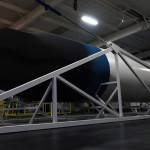
WHY THIS MATTERS IN BRIEF
All of today’s rockets are expensive, complex multi stage systems, but ARCA’s new Aerospike powered rocket will be the world’s first single stage rocket to travel from Earth to orbit.
Today, every rocket that’s launched into space is what is known in the industry as a two stage, or a multi stage, rocket system. In short that means that the lower stage – the one carrying the fuel and the engines – boosts the upper stages into orbit where they all separate and go their own ways, with the lower stage either falling back to Earth, or as is the case with the SpaceX Falcon 9, returning to Earth in a controlled descent, as the upper stages go on to release satellites and platforms into orbit.
It’s an approach that’s complex and expensive – even today as SpaceX do their best to build small, “single core” and heavier “triple core” re-useable rocket platforms, like the Falcon 9 and the Falcon Heavy, that are helping lower the cost of a rocket launch by a hundred fold.
Since the cancellation of the Lockheed Martin X-33 VentureStar program in the early 2000’s though a single stage rocket, powered by a new type of rocket motor technology, called a linear Aerospike, has been little more than a dream for many of those in the industry – including NASA who’ve been trying to perfect the technology since the 1960’s. But now, one New Mexico based company, ARCA Space Exploration plans on making single stage rockets, and the linear Aerospike, a reality, and they’ve just unveiled their new Haas 2CA rocket which will launch early next year.
An Aerospike works by cutting a rocket engine’s bell in half, then placing the two halves back to back to form a tapering spike. The principle behind the Aerospike is that the air itself acts as the missing half of the rocket bell, containing the hot gases as they leave the combustion chamber.
This means that as the rocket flies higher, the thinner air holds the gases less tightly and they spread out more – as if the rocket bell has gradually grown larger. This allows the Aerospike to automatically adjust itself in flight, turning itself from a sea level engine into a high altitude one as the air gets rarer.
According to ACRA, this allows the Haas 2CA to generate up to thirty percent more impulse, or thrust, than today’s best rocket engines. Also, by using 16 combustion chambers that can be individually throttled, the new Aerospike rocket can be steered without the need for a heavy and complex gimbaling system, making the rocket lighter, cheaper and more efficient.
When completed, the Haas will stand 53 ft tall with a diameter of 5 ft and weigh in at 1,210 lb (550 kg) or 35,887 lb (16,290 kg) fuelled, in part thanks to ACRA’s proprietary light, composite materials that they’re using to build the rocket with.
Unlike other systems that use cryogenic propellants, the Haas burns hydrogen peroxide and RP-1 – a highly refined form of kerosene which is capable of punching 50,500 lb of thrust at sea level. This will let the Haas place a payload of 220 lb (100 kg) into low Earth orbit at 24 hours notice for about $10,000 per pound or $4,545 per kilogram, which is much cheaper than even today’s lowest cost SpaceX alternatives.
Aimed at the microsatellite market, the Hass ARCA have co-developed the rocket with NASA’s Kennedy, Ames, Wallops, Marshall, Stennis, and Johnson Space Centers for the Cooperative Opportunity Program, and it’s scheduled to make its maiden flight from the Wallops Flight Facility in 2018. In addition, the company is negotiating to use the Spaceport America in New Mexico as a launch base.
“When the Haas 2CA rocket launches, it will be the first rocket in history to place itself entirely into orbit [as a single stage],” says Dumitru Popescu, ARCA Space Corporation CEO.
“This opens new frontiers for exploration of the Solar System as the rocket can be re-fuelled in orbit and re-utilize its aerospike engine thus eliminating the need for additional upper stages. After the full qualification, the vehicle could be operated from inland spaceports as there are no stages that fall on the ground at burnout. Staged rockets, even though they provide more payload performance for the same take off mass, are less reliable because of an increased number of parts due to flight events requested by staging and ignition of the upper stage engine,” he said.
“Also, staged rockets are deemed to be more expensive because they are literally made up of more than one rocket. Manufacturing and assembling more rockets in one launcher requires more, time, money, and personnel. The SSTO technology, once implemented, will increase the space flight responsiveness and lower the cost to values expected by the industry for decades. This rocket will also be the fastest vehicle to reach orbit, taking less than five minutes.”

























[…] Source link […]
[…] their up and down moments. It was set to be the world’s first flight test for a revolutionary aerospike rocket engine, but the MIRA I prototype from Polaris Raumflugzeuge crashed on take off before the most innovative […]